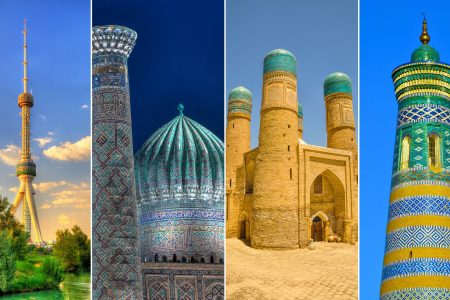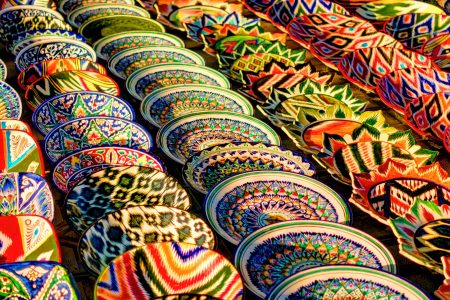The ancient city is over 2000 years old and at this time, it is the capital of the Republic of Uzbekistan. Also known as Tashkent oasis, it is part of a wide plain that begins on the western slopes of Tien Shan mountains on the west and ends at Syrdarya river on the east. The city has a direct border to Kazakhstan to the north. The area of Tashkent is 327.9 km². The current population of the city is over 3 million.
The history of the city goes a couple thousand years back. Within this period, Tashkent has transitioned from being one of the largest and influential cities in the world, to becoming the capital city of the Republic of Uzbekistan. Over the centuries, the city has experienced times of peace and great civilization, but also endured many battles and wars. In fact, Tashkent was destroyed and rebuilt many times. The great scholars of Muslim world, such as Khoja Ahror Wali, Sheikh Umar Boghistani, Abu Bakr Shashi, Abu Sulayman Banokati, Hafiz Kohaki gathered and shared knowledge amongst themselves in this city, and pushed science to new dimensions.
Information about the long history of Tashkent and the ancient Choch or Shosh region is described slightly differently in various written sources. In the ancient Zoroastrian holy book (Avesta), Syrdarya region is called Turon, and the inhabitants are referred to as Tur. It is said that the city of Qangha (Qangha) was the religious and political residence of the tribal elders of the tribes.
Initially, ancient agricultural and urban cultures in Central Asia gradually developed in the Chirchik River Basin. Tashkent became a popular settlement and slowly established itself as a central presence. Known in medieval times as Chach or Shosh, it later became Tashkent.
The name = “Tashkent” is first mentioned in the ancient written works of famous scholars of the 12th century – Abu Rayhan Beruni and Mahmud Kashgari. In his book named “India”, Beruni talks about the origin of the name Tashkent. The word “Tash” (stone) stems from the Turkish language, whilst “Kent” means town, or village. “Tashkent means a rocky village,” he explains. The development of urban culture in Tashkent is a huge historical process in the socio-economic and cultural life of the ancient pastoralists and peasants, who moved to sedentary lifestyles from nomadic tribes. At first, productive lands were occupied for gardening and farming purposes, and afterwards, craftsmanship skill were advanced, which lead the way to regional and cross-regional trade.
The historical landscape of this process is still extremely unrevealed, that it is constantly reconstructed through archaeological findings. Therefore, the results of archeological excavations in the territory of Tashkent clarify and offer new information about the complex history of the region. Nevertheless, more most of its existence, the city was a major presence in the crossroads of the Great Silk Road.
In 2007, Tashkent was declared the center of Islamic culture. This is due to the presence of many historical Islamic buildings in the city, and also by the fact that Tashkent Islamic University and Tashkent Islamic Institute, named after Imam Bukhari, are both located in the city. Today, famous Hasti Imam Complex in Tashkent is one of the favorite places for local and foreign tourists, (15th-20th centuries) which encompasses the tomb of Imam Abu Bakr Muhammad ibn Ali Ismail al-Qaffol Shashi. The cemetery and the architectural complex around it are named after Khasti Imam. The sacred manuscript “The Ottoman Quran” written during the reign of the Caliph Ottoman (644-656) is preserved in Quran`s museum in the same complex* (there are 5 originals available today, one of them kept in Uzbekistan). Therefore, many tourists enjoy visiting this complex as part of an Islamic pilgrimage to observe a holy manuscript, which is famous in the Muslim world.
Tashkent is one of the largest industrial hubs and cultural centers in Central Asia. On top of that, it is becoming one of the largest megacities for international business. Many international and national organization’s headquarters, as well as most of the domestic manufacturing companies’ head offices are located in Tashkent city, producing everything from clothing and electronics to aviation. The capital accounts for about 30% of the country’s output.
Tashkent is also the political center of the Republic of Uzbekistan. The Presidential Administration, Oliy Majlis parties, the Cabinet of Ministers, social movements and parties and public organizations, embassies, UN agencies and other international organizations, governmental as well as non-governmental organizations are hold in this city. Furthermore, the most modern and largest medical institutions, as well as over 30 state and international universities located in Tashkent. You can find anything from luxurious theaters, green parks, luxury sports arenas and entertainment venues, to huge mosques and mausoleums. Tashkent underground metro stations are also famous with their breathtaking beauty and decorations, featuring embroidery in the national style, and attracting tourists from all over the world.
Currently, there are about hundred museums perform in Uzbekistan; the majority museums are located in Tashkent city. Each of them represents the rich cultural heritage of Uzbek nation. In the center of Tashkent city is the State Museum of the History of Temurids, with a huge blue dome that is reminiscent of the ancient domes of Samarkand. Its exhibits testify to the formation of medieval forms of statehood in the territory of Uzbekistan and illustrates the development of science, culture and art during the reign of Amir Temur.



